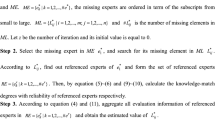Abstract
Nuclear safeguards evaluation aims to verify that countries are not misusing nuclear programs for nuclear weapons purposes. Experts of the International Atomic Energy Agency (IAEA) evaluate many indicators by using diverse sources, which are vague and imprecise. The use of linguistic information has provided a better way to manage such uncertainties. However, missing values in the evaluation are often happened because there exist many indicators and the experts have not sufficient knowledge or expertise about them. Those missing values might bias the evaluation result. In this contribution, we provide an imputation process based on collaborative filtering dealing with the linguistic 2-tuple computation model and a trust measure to cope with such problems.
Access this chapter
Tax calculation will be finalised at checkout
Purchases are for personal use only
Preview
Unable to display preview. Download preview PDF.
Similar content being viewed by others
References
Adomavicius, G., Tuzhilin, A.: Toward the next generation of recommender systems: A survey of the state-of-the-art and possible extensions. IEEE Transactions on Knowledge and Data Engineering 17(6), 734–749 (2005)
Bonissone, P.P., Decker, K.S.: Selecting Uncertainty Calculi and Granularity: An Experiment in Trading-Off Precision and Complexity. In: Kanal, L.H., Lemmer, J.F. (eds.) Uncertainty in Artificial Intelligence. North-Holland, Amsterdam (1986)
Dubois, D., Prade, H.: Incomplete conjunctive information. Computers and Mathematics with Applications 15(10), 797–810 (1988)
Herlocker, J.L., Konstan, J.A., Riedl, J.: An Empirical Analysis of Design Choices in Neighborhood-based Collaborative Filtering Algorithms. In: Information Retrieval, pp. 287–310. Kluwer Academic, Dordrecht (2002)
Herrera, F., Martínez, L.: A 2-tuple fuzzy linguistic representation model for computing with words. IEEE Transactions on Fuzzy Systems 8(6), 746–752 (2000)
Physical model. Int. Atomic Energy Agency, IAEA, Vienna, Rep. STR-314 (1999)
Nuclear Security and Safeguards. In: IAEA Bulletin, Annual Report. IAEA, vol. 43 (2001)
Jiang, N., Gruenwald, L.: Estimating Missing Data in Data Streams. In: Kotagiri, R., Radha Krishna, P., Mohania, M., Nantajeewarawat, E. (eds.) DASFAA 2007. LNCS, vol. 4443, pp. 981–987. Springer, Heidelberg (2007)
Kabak, Ö., Ruan, D.: A cumulative belief-degree approach for nuclear safeguards evaluation. In: Proc. of IEEE Conference on Systems, Man and Cybernetics, San Antonio, TX-USA (2009)
Landgrebe, T.C.W., Duin, R.P.W.: Efficient multiclass ROC approximation by decomposition via confusion matrix pertubation analysis. IEEE Transactions on Pattern Analysis and Machine Intelligence 30(5), 810–822 (2008)
Lee, T.Q., Park, Y., Pack, Y.T.: A Similarity Measure for Collaborative Filtering with Implicit Feedback. In: Huang, D.-S., Heutte, L., Loog, M. (eds.) ICIC 2007. LNCS (LNAI), vol. 4682, pp. 385–397. Springer, Heidelberg (2007)
Lin, J.H., Sellke, T.M., Coyle, E.J.: Adaptive stack filtering under the mean absolute error criterion. In: Advances in Communications and Signal Processing, pp. 263–276 (1989)
Liu, J., Ruan, D., Carchon, R.: Synthesis and evaluation analysis of the indicator information in nuclear safeguards applications by computing with words. International Journal of Applied Mathematics and Computer Science 12(3), 449–462 (2002)
Liu, J., Ruan, D., Wang, H., Martínez, L.: Improving nuclear safeguards evaluation through enhanced belief rule-based inference methodology. Int. J. Nuclear Knowledge Management 3(3), 312–339 (2009)
Martínez, L.: Sensory evaluation based on linguistic decision analysis. International Journal of Aproximated Reasoning 44(2), 148–164 (2007)
Nowicki, R.: On combining neuro-fuzzy architectures with the rough set theory to solve classification problems with incomplete data. IEEE Transactions on Knowledge and Data Engineering 20(9), 1239–1253 (1989)
Oltman, L.B., Yahia, S.B.: Yet another approach for completing missing values. In: Yahia, S.B., Nguifo, E.M., Belohlavek, R. (eds.) CLA 2006. LNCS (LNAI), vol. 4923, pp. 155–169. Springer, Heidelberg (2008)
Pawlak, M.: Kernel classification rules from missing data. IEEE Transactions on Inforamtion Theory 39(3), 979–988 (1993)
Siddique, J., Belin, R.: Using and approximate bayesian bootstrap to multiply impute nonignorable. Computational Statistics and Data Analysis 53(2), 405–415 (2008)
Slownski, R., Stefanowski, J.: Rough classification in incomplete information-systems. Mathematical and Computer Modelling 12(10-11), 1347–1357 (1989)
Zadeh, L.A.: The concept of a linguistic variable and its applications to approximate reasoning. Information Sciences, Part I, II, III 8, 8, 9, 199–249, 301–357, 43–80 (1975)
Author information
Authors and Affiliations
Editor information
Editors and Affiliations
Rights and permissions
Copyright information
© 2010 Springer-Verlag Berlin Heidelberg
About this paper
Cite this paper
Rodríguez, R.M., Ruan, D., Liu, J., Calzada, A., Martínez, L. (2010). Imputing Missing Values in Nuclear Safeguards Evaluation by a 2-Tuple Computational Model. In: Rutkowski, L., Scherer, R., Tadeusiewicz, R., Zadeh, L.A., Zurada, J.M. (eds) Artificial Intelligence and Soft Computing. ICAISC 2010. Lecture Notes in Computer Science(), vol 6113. Springer, Berlin, Heidelberg. https://doi.org/10.1007/978-3-642-13208-7_26
Download citation
DOI: https://doi.org/10.1007/978-3-642-13208-7_26
Publisher Name: Springer, Berlin, Heidelberg
Print ISBN: 978-3-642-13207-0
Online ISBN: 978-3-642-13208-7
eBook Packages: Computer ScienceComputer Science (R0)




